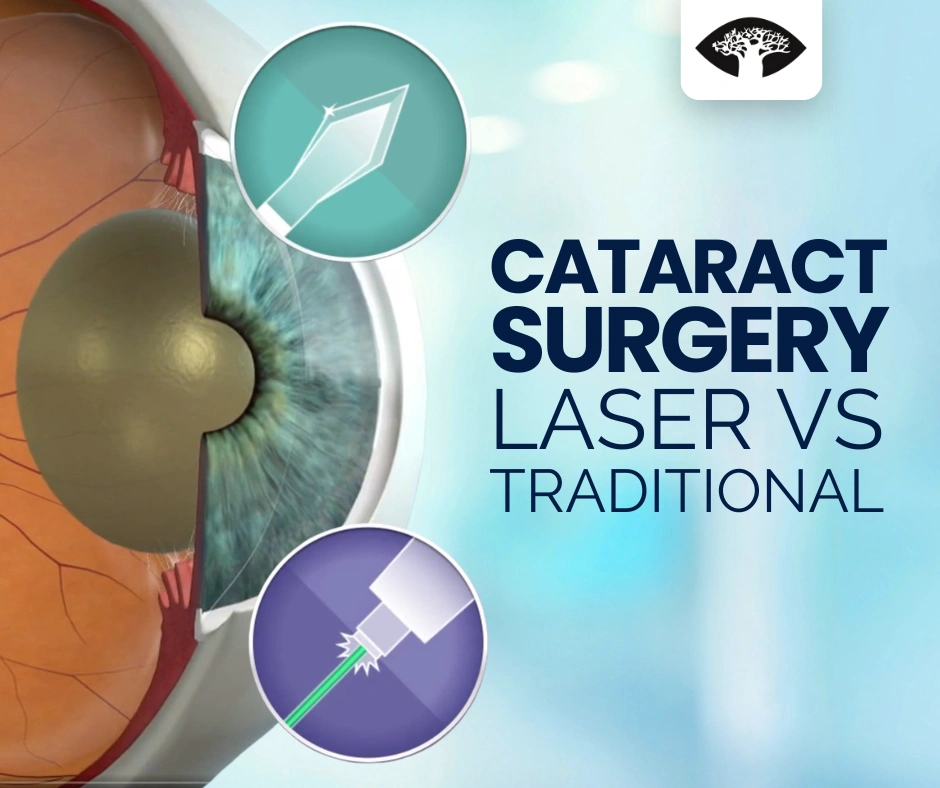Cataracts surgery has changed a lot in recent years. Today, patients can choose from more ways to restore their vision. The two most common procedures are traditional cataract surgery and laser-assisted cataract surgery.
Both methods aim to remove the cloudy natural lens and replace it with a clear artificial lens. The main difference lies in the tools and techniques used. Understanding how they compare helps patients make informed decisions.
Dr. Cronje’s practice provides traditional cataract surgery. This article explains both methods and why traditional surgery remains a trusted choice for many people.
What Is Cataracts Surgery?
Cataracts happen when the natural lens inside the eye becomes cloudy. This clouding can make it hard to read, drive, or see clearly in low light.
During cataracts surgery, the surgeon removes the cloudy lens and replaces it with an artificial intraocular lens (IOL). This new lens focuses light properly onto the retina to restore vision.
Most people consider surgery when cataracts start to affect their daily lives.
To learn more about how cataracts form, visit the American Academy of Ophthalmology.
Traditional Cataracts Surgery
Traditional cataracts surgery, also known as ultrasound-based lens removal, has been safely used for decades.
The surgeon begins by making tiny incisions in the edge of the cornea. They insert a small ultrasound device to break the cloudy lens into smaller pieces. The surgeon then removes those pieces with gentle suction.
They place a new artificial lens where the old one used to be. These small cuts usually heal on their own without stitches.
The procedure takes less than 30 minutes and uses local anaesthetic. You may also receive medicine to help you relax before the procedure. This helps keep you calm and comfortable.
Most patients return to their normal routines within a few days. Vision usually improves within the first week.
Traditional surgery is safe and effective for most people. It also works well for those with eye conditions such as diabetic retinopathy or macular degeneration.
Laser-Assisted Cataracts Surgery
Laser-assisted cataracts surgery uses a computer-guided laser instead of handheld tools for certain steps. The laser creates precise incisions, softens the lens, and opens the lens capsule.
A 3D image of the eye helps guide the laser for better accuracy. This can assist when placing premium lenses or correcting irregular vision.
However, the surgeon still needs to break up and remove the cloudy lens using traditional tools. Laser surgery does not replace the surgeon’s role or the need for ultrasound.
These procedures usually cost more and often aren’t covered by insurance or medical aid. They also may not be available in all clinics due to the cost of the equipment.
For more on this technology, visit the Harvard Health Publishing.
Comparing the Two Approaches
Both types of cataracts surgery aim to improve your vision by replacing the cloudy lens with a clear one. The biggest differences lie in the tools used and the cost.
In traditional surgery, the surgeon manually uses tools to complete the procedure. It’s widely available and more affordable.
Laser-assisted surgery uses advanced equipment to improve precision in certain steps. However, results are often similar for routine cases.
Patients with more complex needs — such as using premium lenses or having specific vision goals — might benefit from laser-assisted surgery. But many people see excellent results with traditional surgery.
These are both valid cataracts surgery options. The right one depends on your eye health, your goals, and what your clinic offers.
When considering cataracts surgery options, it’s helpful to understand why a clinic offers one method instead of another. This supports an informed decision.
Why Dr. Cronje Uses Traditional Cataracts Surgery
Dr. Cronje’s clinic uses traditional surgery because it offers consistent results and works for a wide range of patients. It doesn’t require expensive equipment, which keeps the treatment accessible and cost-effective.
This method is safe, well-studied, and effective for people with different eye conditions, including those who may have cataracts in both eyes.
The team will measure your eye before surgery to select the right lens and ensure a good fit. You’ll also receive an eye drop to prevent infection and protect the eye during healing.
The focus is on high-quality care using trusted techniques.
What to Consider When Choosing a Method
Each patient is different. The decision between traditional and laser-assisted surgery may depend on:
- The type and stage of your cataracts
- Whether you have irregular vision or need a premium lens
- The types of IOLs being considered
- Your overall eye health and daily lifestyle
- Your budget and access to newer equipment
The team will review these details with you to build a personalised treatment plan.
What to Expect After Surgery
Most patients see clearly within a few days after surgery. You may need to wear an eye shield at night to protect your eye while it heals. You’ll also use prescribed eye drops to prevent infection and reduce swelling.
In rare cases, vision may become blurry again due to a condition called posterior capsular opacification. If this happens, a simple laser treatment can clear the clouding.
Moving Forward
Cataracts surgery is one of the safest and most effective ways to improve your vision. While laser-assisted methods offer added precision in some cases, traditional surgery continues to meet the needs of most patients.
If you’re exploring your cataracts surgery options, a detailed consultation will help you choose the method that fits your goals and eye health.
Book Your Consultation
Cataracts surgery is available at Dr. Cronje’s offices in Middelburg, Ermelo, and Piet Retief.


